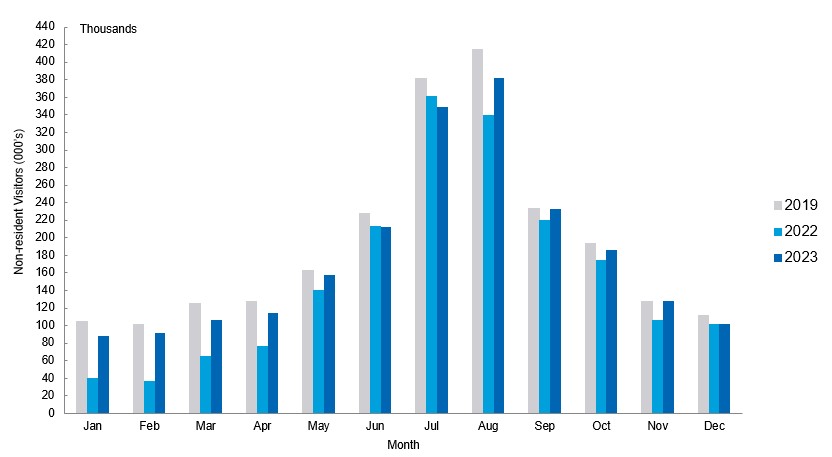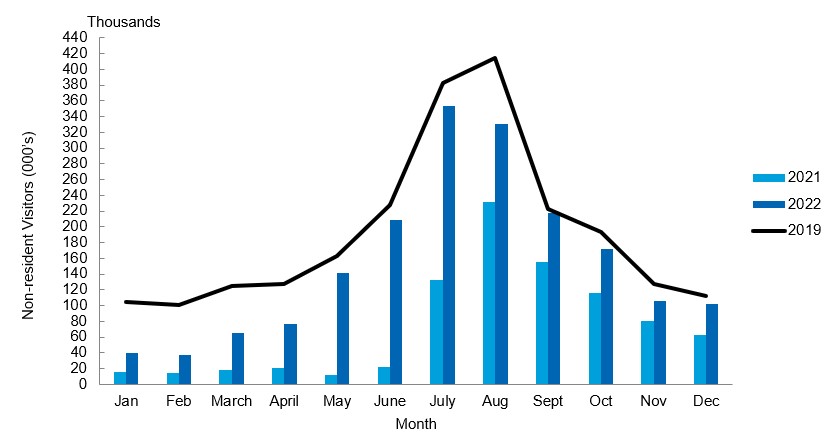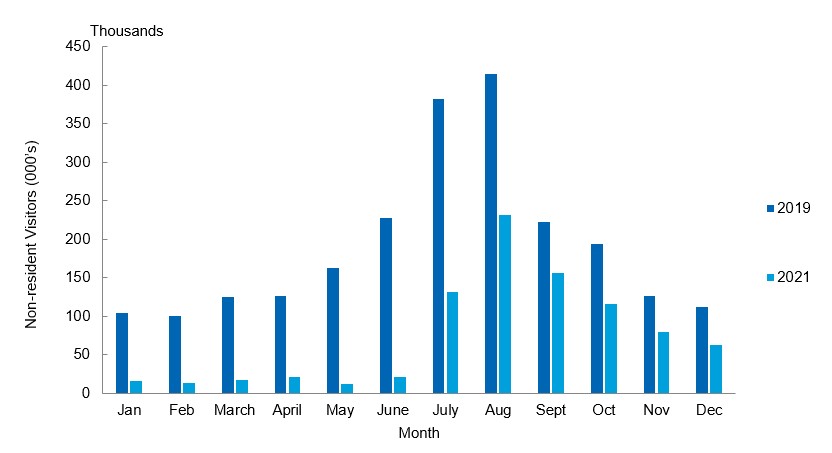Tourism Nova Scotia gathers and reports tourism statistics on behalf of the tourism industry. These statistics help inform our decision-making, help describe visitors to Nova Scotia, and can be used by tourism businesses and organizations for planning and business development. As tourism indicators are compiled from several sources, data becomes available at different times. Tourism Nova Scotia reports the most up-to-date statistics available so reporting timelines for each indicator may differ.
2023 saw strong recovery in visitation to Nova Scotia, however, visitation has not yet returned to 2019 levels.
In 2023, Nova Scotia welcomed 2.2 million visitors, an increase of 14% (or 266,000 more visitors) compared with 2022. Compared with 2019, 2023 visitation was down by 6% (or 149,000 fewer visitors).
Of these 2023 visitors, 1.3 million arrived by road (up 15% compared with 2022 and down 13% compared with 2019). Meanwhile, visitation to Nova Scotia by air increased by 12% compared with 2022, with 813,000 visitors arriving in 2023 (up 7% from 2019).
The primary contributor to lower visitation in 2023 compared with 2019 was softness in visitation recovery from Atlantic Canada and the United States. Specifically, 952,000 Atlantic Canadians visited Nova Scotia in 2023, which is an increase of 24% compared with 2022 (184,000 more visitors) but a decrease of 14% compared with 2019 (156,000 fewer visitors). Atlantic Canadians continue to represent the largest share of visitors, accounting for 44% of all those visiting the province. Visitation from the US also increased in 2023, with 155,000 visitors arriving in 2023 (a 14% increase compared with 2022), however, still down by 33% compared with 2019 (77,000 fewer visitors).
Visitation from Ontario continued the strong growth seen in 2022, with 626,000 visitors arriving in 2023, an increase of 7% (41,000 more visitors) compared with 2022 and an increase of 8% (49,000 more visitors) compared with 2019. Visitors from Ontario accounted for 29% of total visitors to Nova Scotia in 2023.
Visitation from overseas markets increased by 5% compared with both 2022 and 2019, with 90,000 visiting Nova Scotia in 2023.
Non-resident Visitors to Nova Scotia:

Visitation to Nova Scotia recovered substantially in 2022, with Nova Scotia welcoming 1.9 million visitors, an increase of 1 million visitors compared with 2021. Visitation did not reach pre-pandemic levels, with 2022 representing a decline of 18% (or 415,000 fewer visitors) compared with 2019.
Of those visitors, 1.2 million arrived by road (up 82% compared with 2021 and down 25% compared with 2019). Meanwhile, 725,000 visitors arrived by air (up 198% compared with 2021 and down 4% compared with 2019).
Although Atlantic Canadians continued to represent the largest share of visitors, accounting for 41% of overall visitation in 2022, visitation from Atlantic Canada did not recover to the same extent as other markets and was down by 31% compared with 2019. Visitation from Ontario was strong, representing 31% of overall visitation, up 1% compared with 2019. Visitors from Quebec accounted for 5% of visitors, down 9% compared with 2019.
Visitors from the United States accounted for 7%, down by 41% compared with 2019, while overseas visitation accounted for 5% of visitors, and was unchanged from 2019 at 86,000 visitors in 2022.
Non-resident Visitors to Nova Scotia:

See the 2021 Tourism Performance Report (PDF)
See 2021 Visitors by Origin (PDF)
In 2021, Nova Scotia welcomed a total of 882,600 visitors. Based on visitation estimates for 2020, visitation was up 13% in 2021 compared with the first year of the pandemic, an increase of 103,000 visitors. However, compared with 2019, before the pandemic began, visitation was down 62% (or 1.4 million fewer visitors).
Overall, Atlantic Canadians made up 50% of all non-resident visitors through 2021, while visitors from Ontario made up 30%, visitors from Quebec made up 6%, visitors from Western Canada made up 10%, and US and overseas visitors accounted for 4% of visitation.
A total of 639,300 visitors arrived by road in 2021, down 1% compared with 2020 and down 59% compared with 2019. Meanwhile, 243,300 visitors arrived by air in 2021, an increase of 82% compared with 2020, but a decrease of 68% compared with 2019.
Non-resident Visitors to Nova Scotia

About Visitation Statistics
Visitation statistics are compiled from a variety of sources, including:
- In-person surveys administered to passengers at the Halifax Stanfield International Airport
- Motor vehicle enumeration at the Nova Scotia – New Brunswick border
- Passenger information from ferry operators
- The Nova Scotia Visitor Exit Survey
- Data from Halifax International Airport Authority
- Visitor data from provincial and community visitor information centres
- Cruise passenger data from Halifax Port Authority and Sydney Ports Corporation
- Attendance data from select tourism operators
These statistics reflect the combined efforts of tourism businesses, organizations, communities, and governments, and include activities by both Nova Scotians and non-resident visitors. There are many factors that contribute to tourism industry performance including events, weather, gas prices, air capacity, currency fluctuations, geo-political circumstances, and industry initiatives such as marketing. Tourism Nova Scotia is just one organization among many contributing to tourism growth. We support tourism growth through marketing in key national and international markets, support for experience and business development, and visitor servicing. For more information about Tourism Nova Scotia's strategy and performance, please see Plans & Reports.